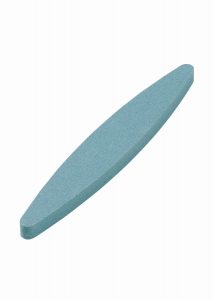Need help learning how to use a sharpening stone? You’ve come to the right place. Whether you are sharpening your Woodman’s Pal, an ax, or some other blade, this guide can provide the basic information you need to get started with your sharpening stone.
How Does a Sharpening Stone Work?
Sharpening stones use friction or the process of abrasion to wear down the edge of your blade until it is shaped properly for cutting. But all  sharpening stones are not created equally — a professionally-made sharpening stone should include product information that indicates the ‘grit’ of the stone, or how coarse or fine the stone is. The lower the number, the more coarse the sharpening stone’s grit is. The higher the number, the finer the grit.
sharpening stones are not created equally — a professionally-made sharpening stone should include product information that indicates the ‘grit’ of the stone, or how coarse or fine the stone is. The lower the number, the more coarse the sharpening stone’s grit is. The higher the number, the finer the grit.
A coarse sharpening stone between 120 and 240 grit is best for buffing out deep chips or extremely dull blades, while finer grits ranging from 700 to 2000 are best for routine sharpening.
Benefits of Using a Sharpening Stone
Once you learn how to use a sharpening stone, the benefits are noticeable right away. Traditional sharpening methods that allow you to simply slide a blade through a small slot are certainly useful, but mostly just for routine sharpening. If you have a blade with serious knicks and chips on it, a sharpening stone allows you to pay more attention to problem areas where the metal could potentially get caught in a regular household sharpener. Sharpening stones also provide an authentic feel and experience for people who love the outdoors.
Sharpening Stone Applications
The best thing about sharpening stones is that they can be used for almost any blade! Once you know how to shape worn blades with a sharpening stone, you will find countless applications for using it. A sharpening stone can be used on hunting knives, fishing knives, axes, hatchets, and even machetes! That’s why we include a Lanksy sharpening stone with every Woodman’s Pal.
How to Sharpen Machetes With a Sharpening Stone
Before we explain how to sharpen a machete with a sharpening stone, it’s important to note that machetes generally are not meant to be razor-sharp at all times like a knife. Moreover, the ideal angle for your machete’s blade may vary depending on your intended use.
For cutting down grass and non-woody plant material, a sharpening angle between 20 and 25 degrees is ideal. For cutting saplings, branches, and other woody vegetation, a larger angle between 25 and 35 degrees will be more durable for your machete’s blade.
As far as technique goes, all you need to do is run your sharpening stone along the blade’s edge at your desired angle using steady and consistent strokes. You can use oil or water as a lubricant when sharpening a machete with a sharpening stone. If you opt for water as your lubricant, just be sure to soak your sharpening stone for at least 15 minutes beforehand.
Get a Free Sharpening Stone With Your Woodman’s Pal
Now that you know how to sharpen a machete with a sharpening stone, it’s time to put that knowledge to the action! But no matter how skilled  you may be with your sharpening stroke, a machete is only as effective as the person swinging it, and the materials and methods used to create that machete. The Woodman’s Pal accounts for all of these factors with an ergonomic design, superbly balanced weight, and precision laser-cut spring steel blade. In other words, the Woodman’s Pal is designed for easy use, simple maintenance, and incredible durability.
you may be with your sharpening stroke, a machete is only as effective as the person swinging it, and the materials and methods used to create that machete. The Woodman’s Pal accounts for all of these factors with an ergonomic design, superbly balanced weight, and precision laser-cut spring steel blade. In other words, the Woodman’s Pal is designed for easy use, simple maintenance, and incredible durability.
When you purchase a Woodman’s Pal machete, a Lansky sharpening stone is included in the custom Woodman’s Pal gift box that you’ll receive. Considering the finely-crafted nature of Woodman’s Pal blades, you probably won’t use the sharpening stone very often — but at least you know how to use it when that time comes. Order your own Woodman’s Pal today so you can start practicing your sharpening stone technique as soon as possible!


